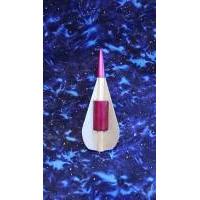Sunward Aerospace Interplanetary Shuttle
Sunward Aerospace - Interplanetary Shuttle {Kit}
Contributed by Misty Stromme
| Construction Rating: | starstarstarstarstar_border |
| Flight Rating: | starstarstarstarstar |
| Overall Rating: | starstarstarstarstar_border |
| Published: | 2016-08-01 |
| Manufacturer: | Sunward Aerospace  |
 Brief
Brief
This kit caught my eye because of its unique look and spacey design.
Components
The kit comes with a motor mount assembly, body tube, laser-cut balsa fins, a larger diameter central tube and end rings, a shock cord and parachute (requires assembly), and finally a plastic nose cone and an ample amount of clay for nose weight.
Construction
I am a beginning modeler, and I found the construction of this kit fairly straightforward. The large center tube had deep spirals, so I used wood filler and sanded it before gluing in place.
Having read other reviews of this kit, I expected it to be unstable, spiraling out of control with every flight. With that thought in mind, I did not want to put too much work into it so I did not prime or fill the fins.
I painted the body and fins seperately before assembling. I glued the fins on using CA, then applied white glue fillets. The tricky part here was getting the fins sanded so they fit around the center tube just right. That is where the kit earns its skill level 2 designation.
After attaching the fins, I proceeded to add clay to the nose cone. The instructions are not specific here. They simply state "Add clay to the nose cone." Umm... How much? So I filled the front portion of the nose with clay. Then, after reading over the reviews again and running a RockSim simulation, I decided to go ahead and stuff some more clay in there, just in case. I filled the back half of the nose cone so there was no space left. Then, I glued the nose cone shut.
Finishing
This kit was not too challenging to build. If I were to do it again, I would sand and fill the fins first, although I kind of like the rough texture on my rocket since it makes the sparkly silver paint seem even more reflective.
The instructions are definitely intended for someone with experience building model rockets. The only thing I would add is some decals to make it look cooler. But I am overall very satisfied with this kit.
Flight
For the first flight, I picked a B6-4 motor. Given the weight of the rocket, I figured it would need more "oomph" to get it off the ground. There was a slight breeze, so I leaned the launch rod slightly. (As it turns out, that was not necessary.) I pressed the button and crossed my fingers. ... The rocket turned slightly (a result of the launch rod being angled) and arced up for a perfect flight. The second flight on a C6-5 went straight up (I corrected the launch rod this time), did an S-curve up high, then the parachute deployed.
Recovery
On the first flight, I completely forgot the wadding. Oops! Still, the parachute deployed just fine and the rocket landed without incident.
For the second launch, I remembered the wadding. The parachute opened and the rocket landed, again without damage.
Summary
I was pleasantly surprised with this rocket. Not only does it look cooler than I expected, but its performance was much better than I anticipated. It's a fun rocket to fly! My only suggestion would be to add as much nose weight as you can and fly it on a calm day.
Sunward could improve this kit by offering decals.
Other Reviews
- Sunward Aerospace Interplanetary Shuttle By Nick Esselman
Photo from Sunward that enticed me to purchase the Interplanetary Shuttle™ The Sunward Interplanetary Shuttle caught my attention despite the unfinished look of the advertisement. I thought the center tube looked really interesting. The overall look was unique with the the fins wrapping around the center tube and extending ...
 |
 |
Flights
Sponsored Ads
 |
 |












